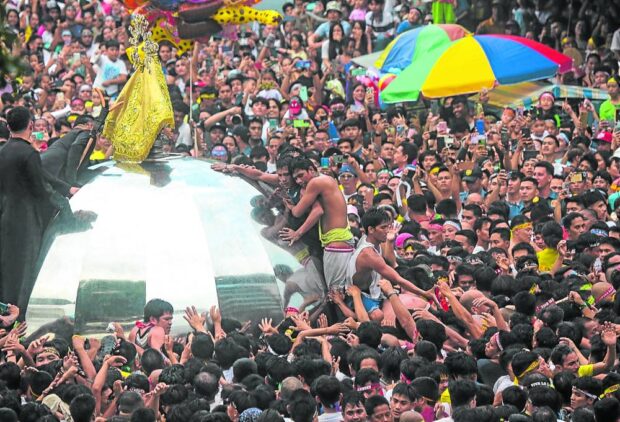
UP CLOSE Several devotees risk injury to get close to the image of the Our Lady of Peñafrancia during the “traslacion” (procession) for the patroness of Bicol in Naga City on Friday. The religious
event, one of the biggest in the country, is held in-person for the second year since its resumption in 2022 after a two-year halt due to pandemic restrictions.—MARK ALVIC ESPLANA
NAGA CITY—Maria Bical Raynes, 84, a resident of San Vicente village in Libmanan town in Camarines Sur province, some 35 kilometers away, did not mind the scorching heat on Friday when she traveled here to watch thousands of devotees join the traslacion (procession) for the Our Lady of Peñafrancia, the patroness of Bicol whom they fondly call “Ina” (mother).
“I don’t want to miss the traslacion. It has been my devotion since I was a child and I want to thank my parents for helping me build a strong foundation of faith in God and in Mama Mary,” she told the Inquirer.
She attributed her good health to her devotion to the Lady of Peñafrancia, including praying the rosary and attending Mass every day.
“During my younger years, I was among the ‘voyadores’ but now I am content with just watching the traslacion,” she added. Voyadores are people who carry the Marian image during the procession.
Japhet Rebotica, 20, from Legazpi City in nearby Albay province, said it was his first time to watch the traslacion of Bicol’s beloved patroness, which is said to be the largest Marian procession in Asia.
“I just wanted to experience how thousands of devotees flock and unite in worshiping and showing their love for Ina,” he said.
Rebotica said watching the traslacion was also his way to “reconnect with God through the intercession of Our Lady of Peñafrancia” since he could not attend Mass on Sundays.
Jesus Balane, a 69-year-old devotee from this city, said it made him “feel great” to still join the procession at his age.
“It has been my personal vow to be part of the procession. I’ve been doing this for a long time and I was among the voyadores for 45 years,” Balane said.
He said his wife had suffered from a heart ailment for years and he would dress her up like the Virgin Mary while she was confined in the Philippine Heart Center.
“Because of our strong faith in God and through Mama Mary, my wife recovered from her sickness,” Balane said.
Tight security
To maintain order during the religious activity, security measures were tightened along the route of the traslacion, including closing some major thoroughfares to traffic.
In a phone interview, Police Brig. Gen. Westrimundo Obinque, Bicol regional police director, said 1,500 policemen were tapped for the event.
“This is to secure the devotees and most importantly to maintain the peace and order during and after the event. I also ordered our policemen to be strict while observing maximum tolerance,” he stressed.
Aside from policemen, rescue teams from the city government and Philippine Red Cross were on standby to respond to medical and health emergencies, Obinque said, noting that signal from telecommunications companies was cut off before the procession as safety precaution.
Different nongovernmental organizations also gave out food, like porridge, and drinks to devotees. Food stations were put up along the procession route.
Authorities on Friday had yet to provide a crowd estimate during the traslacion, which drew over half a million devotees last year after it resumed following a two-year hiatus due to COVID-19 restrictions.